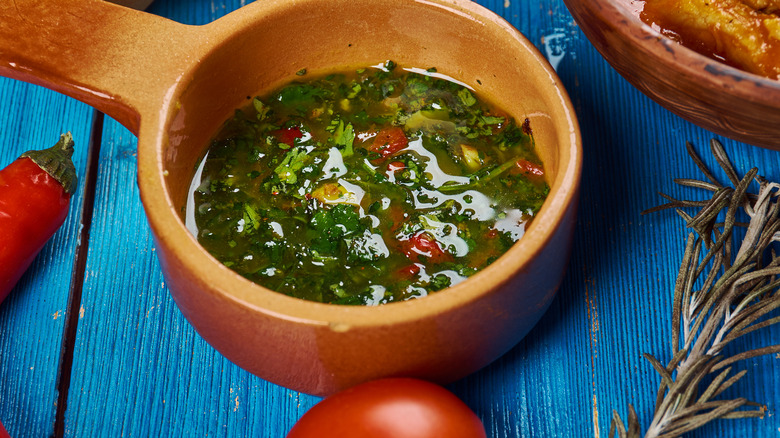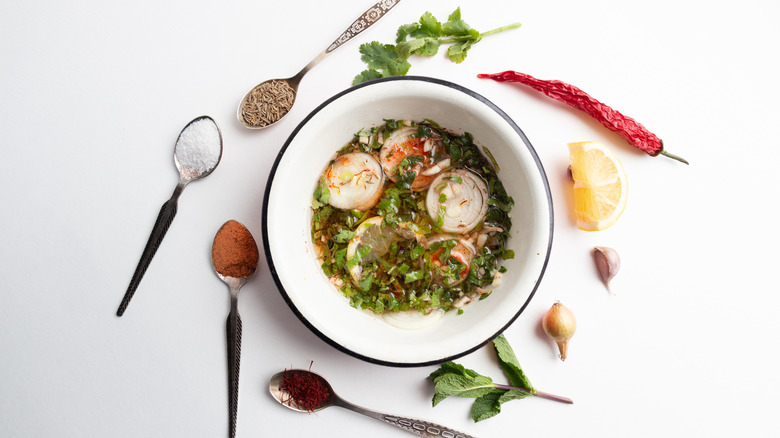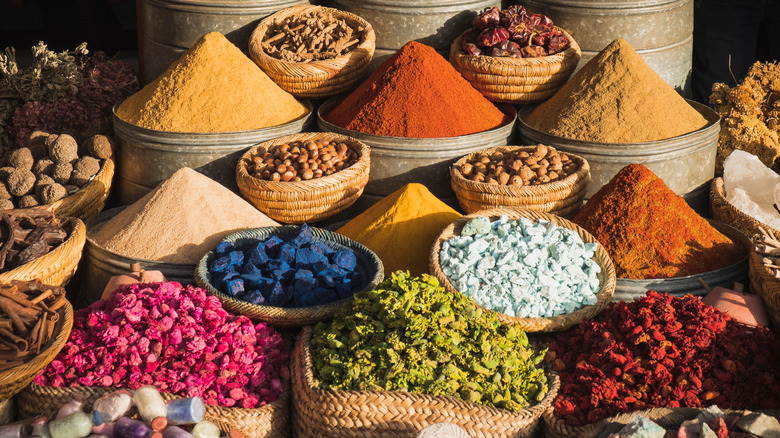What Is Chermoula And How Do You Cook With It?
Famous for its souks, the outdoor markets traditional to North Africa and the Middle East (per Merriam-Webster), Morocco is a country that takes pride in its spices. Around 4 p.m. each evening, AFAR relays how the medinas of cities like Marrakech fill with energy. Herbalists and spice traders come into the city to set up shop, saturating the atmosphere with vibrantly-colored spices and aromas — from orange to yellow turmeric, to deep red paprika and sapphire-hued saffron, to the golden-brown shades of cumin, cardamom, and coriander. For centuries, these markets have permeated Moroccan culture and cuisine, where the spices are brought home with locals to create the famous flavor blends that have made Moroccan food recognizable to the rest of the world, one of those being chermoula.
Born from Moroccan kitchens, chermoula brings rich and herby spices like coriander and cumin together with spicy, fresh chilies (via NPR). Blended into olive oil, the mixture transforms into a paste traditionally used to season grilled fish but has now come to life in dishes with meat, poultry, and even vegetables. Deep and herbaceous with a faint amount of heat, Chef Marcus Samuelsson told NPR that chermoula is the heart of Moroccan food — and it continues to win over the hearts of many more.
How is chermoula made?
Paula Wolfert, the author of the James Beard award-winning cookbook, The Food of Morocco, writes that there isn't one way to make chermoula. Chermoula's famous flavor has spread across North Africa, from Morocco to Tunisia and Algeria, to the south of France, and even Washington D.C., where it was served at the White House during the U.S.-Africa Leaders Summit. But, as Wolfert explains in her book, chermoula is made differently depending on where you are. Even in its origin country of Morocco, the spice blend can vary from city to city and from spice vendor to spice vendor.
Wolfert writes, "In Marrakech, a cook might add some ginger to the spice mix. In Agadir, creamed onions are often added. In Tetouan, a little hot red pepper oil, and in Tangier, our housekeeper always added a little thyme." However, for some guidance, Chef Marcus Samuelsson, who was born in Ethiopia and specializes in African cuisines, tells NPR that most Moroccans start with a base blend of el ras hanout, which includes cumin, cardamom, and coriander. From there, each spice vendor or chef will add their own touches. Common additions include chilis, ginger, lemon zest or juice, saffron, and herbs such as dill or parsley.
Once you've made up your mind about your chosen spices, the challenging part of making chermoula is over. All that needs to be done now is to mix them together, which can be done using a mortar and pestle or food processor.
Cooking with chermoula
As Samuelsson told NPR, "Anytime you say chermoula, people think flavorful, and they smile and they want to have it with their meal." Typically, chermoula is mixed with olive oil and used as a spice rub or marinade. It was originally used to flavor grilled fish, where it's preferably spread over whole or filleted halibut, mahi-mahi, striped bass, or any other white fish (per The New York Times). It's still enjoyed this way to this day. However, chermoula's flavors lend it to many other uses as well.
Samuelsson told NPR that chermoula "has a hint of floral and it has flavor, but it's not super spicy. That's why it's not offensive." Unoffensive is right — chermoula is so friendly that an article from Epicurious goes as far as using it in nine different dinner options. While a couple of those options are as a marinade, your choices aren't just limited to grilled fish. Chicken thighs, tenders, or cutlets, lamb or pork chops, and fish sticks are all potential vessels for chermoula's flavors. Hodo even offers pre-seasoned chermoula tofu cubes. But it can be even simpler than that.
Quick ways to utilize chermoula in your kitchen include tossing it into pasta, salad, or a side serving of vegetables. You can also mix a dollop into plain yogurt, spoon it into a hummus dip, mix it into warm soup, or even put it on a nice, crusty flatbread with your choice of toppings.
Where to buy chermoula
When shopping for chermoula, there's no arguing that the best of the best comes from Morocco. Should you find yourself strolling the ancient medinas of Marrakech sometime in the future, you'd be wrong not to visit at least one of its famous souks. There, you'll find local dealers selling opulent Berber rugs, Moroccan lanterns, dishware, and, of course, spices (via The Culture Trip). While it might take some bargaining, per AFAR, and possibly a beginner's knowledge of Arabic or French, it'll be worth it to get your hands on authentic chermoula made at the hands of a Moroccan herbalist or spice trader. Just be sure to get some to bring home to your friends, too.
While not all of us may have the opportunity to visit Morocco in our lives, or at least not any time soon, there are other ways to get your fix of chermoula. Should you have all of the herbs on hand, it's rather simple to make yourself at home. However, there are also brands like Villa Jerada that sell Moroccan pantry items — including their award-winning chermoula spread — at specialty stores and markets across the United States.



